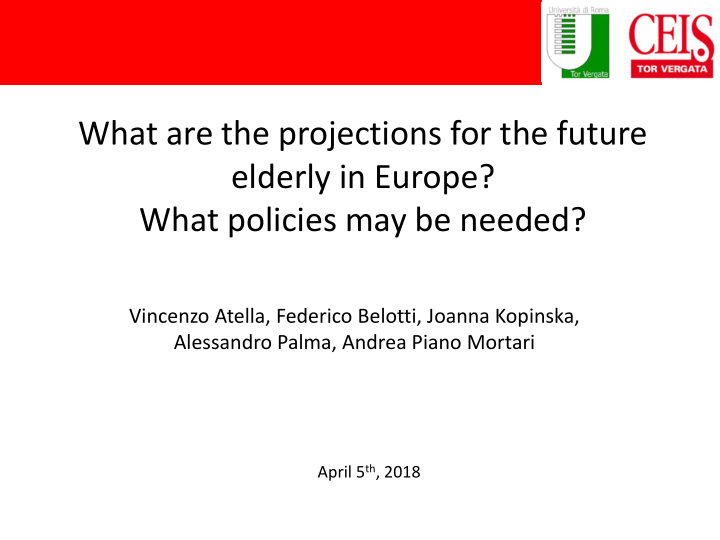



What are the projections for the future elderly in Europe? What policies may be needed? Vincenzo Atella, Federico Belotti, Joanna Kopinska, Alessandro Palma, Andrea Piano Mortari April 5 th , 2018
Outl tline • Background and motivation • The EU-FEM model • Results
Background and motivation • The impact of ageing population represents a main concern around the world and, in particular, in Europe which will be turning “increasingly grey” in the upcoming decades . • As a result, the demographic old-age dependency ratios are projected to almost double from now until 2060, moving from 4 to 2 working-age people for every person aged 65 and above(EC, 2015). • From a macroeconomic perspective, this implies that the projected potential GDP growth will remain much lower than in previous decades. • Aging of the population, combined with the weak economic growth, result in increasingly stringent public finances with serious threats to the financial sustainability of the social security and healthcare systems
Background and motivation • Life expectancy (LE) and fertility rates are the key features of the current aging process in Europe and around the world (Cutler and Meara, 2013). • Medical technologies are among the main determinants for the increase in LE: they have turned many, once deadly diseases into chronic conditions. This phenomenon has been more sustained in Europe with respect to other parts of the world, placing the EU-28 among the worldwide leaders for LE.
Background and motivation • A longer LE can be seen as a potentially “good" or “bad" news , depending on the quality of the “extra” life years lived. In particular, at aggregate level, an older and unhealthy population implies an extra burden in terms of both pensions and health care expenditure. • According to GBD (2016), despite global health improvement and life expectancy increases, people spend more time with reduced functional health status.
Background and motivation • These results are particularly true for high income countries during the 1990-2015 period, when trends in years of functional health loss have increased more than expected and similar trends are forecasted for the near future. • Since 2000 many countries have witnessed a significant decline in healthy life expectancy at birth, inverting what had been a continuous growth process. • This decline has been particularly marked in Europe, with significant differences across geographical areas, and more importantly, across gender: women, tend to live longer, but spend more years in bad health with respect to men.
Background and motivation • Accurate forecasts of future trends in population health could thus offer important support to policy makers in order to design and implement effective and sustainable policies. • In spite of the existence of reliable long-term models predicting population structure by age and sex, long-term forecasts of population health exist only in the US (Goldman et al., 2013) and UK (Guzman-Castillo et al., 2017).
Background and motivation • Concerning Europe, the only available tool for policy makers is the one implemented by the Ageing Working Group (AWG) of the European Commission (EC, 2015), which predicts long- term trends in social security expenditure based on predictions of GDP rather than on estimates of population health status. • Similar information is missing in all other countries.
Background and motivation • According to the last report of the AWG: • Projecting the future evolution in the health status of the population is challenging due to the difficulties associated with predicting the changes in morbidity and measuring ill-health. • While the evolution in mortality rates and life expectancy can be estimated on the basis of administrative information (censuses, surveys, etc.), epidemiological data is subject to much higher uncertainty. • Therefore we rely on three different hypotheses on population health status evolution to predict a possible future interaction between evolution in life expectancy and changes in the prevalence of disability and ill-health • In this context, the availability of a reliable quantitative tool able to assess the impact of future demographic and epidemiological changes on population health status and healthcare demand, and on governments’ budget is crucial.
The model EU-FEM + oth EU ther FEM lik like models ls • The FEM is unique among existing models that make health expenditure projections. It is the only model that: • projects health trends rather than health expenditures. It is also the only model that generates mortality out of assumptions on health trends rather than historical time series. • represents a multi-risk factor, multi-disease model capable of assessing policies to improve chronic care delivery and thus assessing the trade-offs between primary prevention, secondary prevention and treatment alternatives.
The model l str tructure New age New age New age 51-52, 51-52, 51-52, 2012 2014 2016 Population Population Population Population Population … age 51+, age 51+, age 53+, age 51+, age 51+, 2010 2012 2012 2014 2016 Health and Health and Health and spending spending spending outcomes, outcomes, outcomes, 2010 2012 2014 Policy Outcomes Module Replenishing Cohort Module Health Transitions Module 12
Countries in included in in th the EU-FEM model
Variables modeled Economic Outcomes Health Outcomes Other Outcomes Employment status Death Income Tax Revenue (TBA) Earnings Heart diseases Soc. Security Revenue Demographics Stroke Social Security Outlays Medical Expenses Cancer Retirement and pension Med. Expenses by type Cancer by ICD9 categories Productivity (TBA) Wealth Hypertension Health Insurance (TBA) Diabetes Disability insurance (TBA) Lung Diseases Pain Arthritis Osteoporosis (TBA) Parkinson (TBA) BMI Smoking status ADL status IADL Status Life Expectancy Disease free Life Expectancy QALYs
Result lts for EU-FEM FEM
Result lts for EU-FEM FEM
Result lts for EU-FEM FEM
Result lts for EU-FEM FEM
Result lts for EU-FEM FEM
Result lts for EU-FEM FEM
Result lts for EU-FEM FEM
Result lts for EU-FEM FEM
Result lts for EU-FEM FEM
Result lts for EU-FEM FEM
Result lts for EU-FEM FEM
Thanks for the attention
Recommend
More recommend